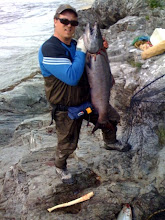
Shishmaref - The People and The Art
Working in Alaska has brought to me a unique opportunity to spend time with an incredible community, Shishmaref. Located on the coast of Alaska, just below the Arctic Circle, this native Alaskan community bears witness to both an ancient way of life and the ever changing world around us.
I plan to do a few blogs about my trips to this corner of the globe, but first I might show you some of the art that these people have become famous for. Most of the pieces I bought on Shishmaref. One of the masks I bought in Nome, but it was made by an artist on Shishmaref. Aside from their normal hunting and fishing activities, much time is dedicated to making their art. There is a strong sense of tradition in Shishmaref, with many of the younger generation embracing the need to keep this art form alive. The art they make is intended to be sold, lest anyone think the good folks of Shihsmaref are being taken advantage of. Selling the art give many of the people a source of income needed to support themselves and their family in bush Alaska.
The figure above was the first piece of art I acquired. It is one of the classic forms common to Shishmaref. It is a hunter with a spear. The hunter is made from whale bone, with the face being an inset piece of caribou horn. The spear tip is made from walrus ivory with the blade being balene. The spear rope is ugruk (bearded seal) gut. The inset marks on the hunter are also balene.
These two pieces are called wall hangings. Made from whale bone, the eyes are ivory with balene insertsas are the two inserts below the mouth. The mouth inserts traditionally signified someone of great importance. There is a name for the mouth inserts, but the word escapes me. The figure on the left I bought in Nome, with the right figure aquired on Shishmaref itself.
The last figure we have is called a horn doll. It is made with a caribou horn, clothed with various furs. This one has ugrok, caribou, and I beleive rabbit. The face of the doll is painted.
So what does this posting have to do fish fishing? The people of Shishmaref ice fish during the winters, and likely are the same people who helped inspire the Alaska Mary Ann fly.
Mostly for me, however, the blog is a way to share something not a lot of people get a chance to see.
If Shirley and Cliff are reading this, thank you for your ongoing hospitality. The sourdoughs are awesome.






